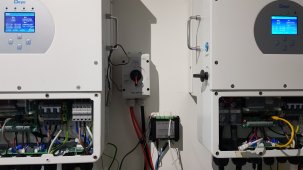shadowmaker
Solar Addict
It seems I can connect either one of my Deye 12Ks to my Eastron SDM630 Modbus V2 meter to get CT readings, but not at the same time for some reason. I couldn't use original CTs that came with the inverters because i have 75m to my main panel. Here's my setup (left one connected in the picture):

The blue CAT5e carries Eastron signal (RS485B-,RS485A+,GND) to an active RS232/RS485 splitter. Actually the splitter has only RS485B- and RS485A+ terminals on it, so I'm using RS232 port's ground terminal to carry ground signal over the splitter also. It seems ground signal isn't all that important for RS485 to work, but I have read that it is better to include it than not (it doesn't seem to change anything, connected or not). I can change CT signal on the fly (RJ45 connectors to Deye's meter port) and it works just fine as long as I don't connect both at the same time. If I do that the CT readings start to fluctuate wildly. I think I have proper connections/configurations as I can get both working separately, but there still is something fishy going on here.

The blue CAT5e carries Eastron signal (RS485B-,RS485A+,GND) to an active RS232/RS485 splitter. Actually the splitter has only RS485B- and RS485A+ terminals on it, so I'm using RS232 port's ground terminal to carry ground signal over the splitter also. It seems ground signal isn't all that important for RS485 to work, but I have read that it is better to include it than not (it doesn't seem to change anything, connected or not). I can change CT signal on the fly (RJ45 connectors to Deye's meter port) and it works just fine as long as I don't connect both at the same time. If I do that the CT readings start to fluctuate wildly. I think I have proper connections/configurations as I can get both working separately, but there still is something fishy going on here.


